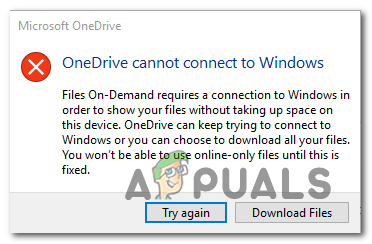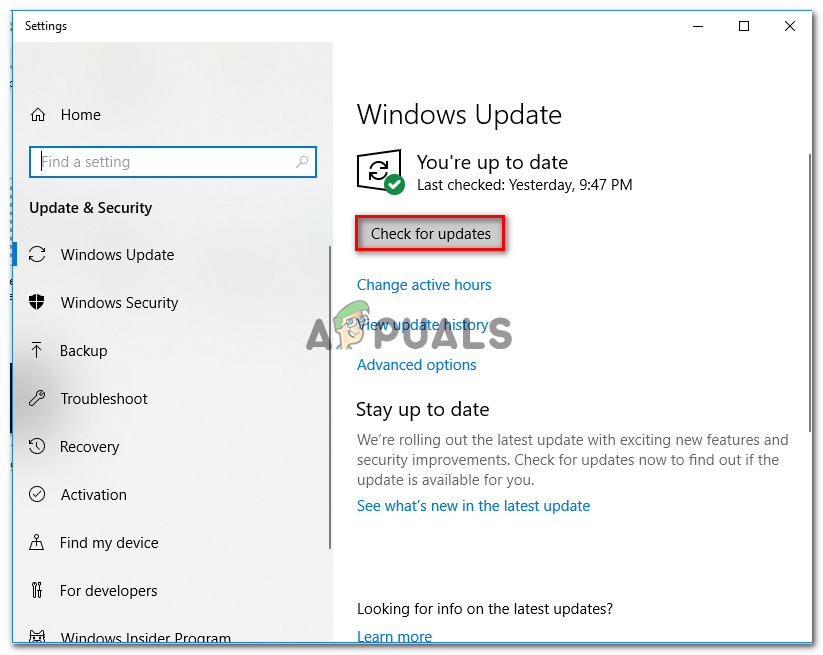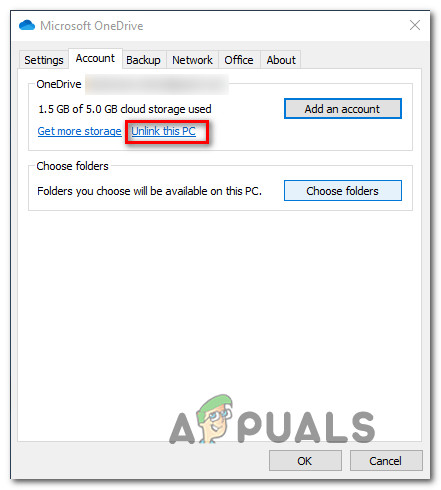OneDrive Connectivity Issues on Windows 7 and 10 [Fix]
The ‘OneDrive Cannot Connect to Windows‘ error typically appears when the user attempts to access items in your OneDrive folder. This error is only reported to occur if the user has previously enabled Files on Demand in OneDrive’s settings.

What Prevents OneDrive from Connecting to Windows
- Windows 10 bug – Windows 10 builds older than build 17046 are all subjective to be affected by a bug that interrupts communications between the cloud server and the local syncing feature of OneDrive. Fortunately, this bug was patched with newer builds, so if this scenario is applicable, all you need to do is update your Windows version to the latest in order to fix the issue.
- Sync-location is incorrect – This error can also appear in those instances where the Files On-Demand feature was recently activated but the sync location that’s being used is set to a USB drive or external HDD / SSD. In this case, you can fix the issue by unlinking the PC from the OneDrive account and adding it again (forcing the path to refresh).
- Network inconsistency – As it turns out, a network inconsistency can also be responsible for the apparition of this error message. Several affected users have confirmed that the issue has been resolved entirely after they did a complete TCP / IP reset and restarting the affected machine.
- Cldflt.sys driver is disabled – One potential scenario that might lead to this error is an instance where the Files on Demand feature is enabled but the cldflt.sys driver is not enabled. If this scenario is applicable, you will need to do some adjustments via an elevated CMD terminal to ensure that the cldflt.sys driver is forced to run.
- 3r party AV/firewall interference – If you use a 3rd party AV or firewall and you didn’t update to the latest version in order to patch this incompatibility, chances are you are encountering this issue due to the fact that your AV is preventing the syncing feature of Onedrive from accessing cloud files. If you don’t want to update your Windows build, the only way to fix the issue is by uninstalling the security suite (or disabling the real-time protection).
- System file corruption – In rare circumstances, this issue can also occur due to some Windows file inconsistencies. This will most commonly appear after a security scan ended up quarantining some items. If this scenario is applicable, you can fix the issue by refreshing every OS component with a procedure like a clean install or repair install.
How to fix the OneDrive cannot connect to Windows Error?
1. Update Windows to latest version
As it turns out, in most cases, this issue will occur due to a bug that was fixed in Windows 10 versions newer than build 17046. In most cases, this problem is facilitated by the interaction between a 3rd party antivirus and the syncing feature of OneDrive.
If this scenario is applicable, the easiest way to fix it is to update your Windows 10 build to the latest build available. This operation should allow you to fix the ‘OneDrive Cannot Connect to Windows‘ error regardless of your Windows 10 version (Standard, Pro, Enterprise, etc.).
The update that’s capable of resolving the issue will be automatically installed by one of the Important updates that are pending if you don’t have the latest available build. Here’s a quick guide on updating your Windows 10 version to the latest build:
- Open up a Run dialog box by pressing Windows key + R. Next, type ”ms-settings:windowsupdate” and press Enter to open up the Windows Update tab of the Settings app.

Opening the Windows Update screen Note: In case you want to update Windows 7 or Windows 8.1 to the latest version, use the ‘wuapp‘ command instead.
- Once you arrive inside the Windows Update screen, start by clicking on Check for updates. Next, start following the on-screen prompts to complete the installation of every Windows update that is currently waiting to be installed.

Installing every pending Windows update Note: While you’re at this step, is important to ensure that you install every pending update including cumulative and security patches, not just the Important packs.
- In case you have a lot of pending updates, chances are you will be prompted to restart your computer before you have the chance of installing every update. If this happens, do so, but make sure to return to the same Windows Update screen once the next startup is complete to complete the installation of the remaining updates.
- Finally, after every pending update is installed, restart your computer one final time and see if the issue is resolved at the next computer startup.
If you noticed that the ‘OneDrive Cannot Connect to Windows‘ persists and you’re still seeing it when attempting to access some files I OneDrive, move down to the next potential fix below.
2. Unlink PC from the Onedrive account
Another popular reason that will end up triggering this error message is a sudden activation of the Files On-Demand features.If you have been using the OneDrive syncing features without Files On-Demand and you suddenly do enable it, you might start seeing the ‘OneDrive Cannot Connect to Windows‘ error.
This happens due to the fact that the sync location that’s being used is not the local hard drive. It’s likely that the configuration is using an external USB drive or hard drive, which is not fully supported by OneDrive.
If this scenario is applicable, you can fix the issue by accessing OneDrive’s sync client settings tab (from the systray), access the Account settings and unlinking the PC that’s causing the issue with the OneDrive account.
Several affected users that encountered this issue have reported that the issue was resolved after doing this and re-adding their account (while making sure that they force the app to use the local hard drive).
Here’s a quick guide on relinking the Onedrive account in order to avoid the ‘OneDrive Cannot Connect to Windows‘ error:
- First things first, make sure that the main OneDrive service is open. Next, click on the taskbar icon (systray) in the bottom-right corner and click on More > Settings.

Accessing the Settings menu of OneDrive - Once you manage to get inside the main OneDrive menu, go ahead and select the Account tab from the horizontal menu. Next, click on Unlink this PC to remove the current account.

Unlinking the OneDrive account from this PC - At the confirmation prompt, click on Unlink Account once again to confirm the operation. After the process is complete, restart your computer to clear any temp data.
- After the next startup sequence, open OneDrive once again and insert your email and password to sync your account with the PC once again.

Signing with OneDrive again Note: If you are prompted to select which location you want to use for OneDrive, ensure that local drive space is selected so that you don’t encounter the same issue in the future.
- Attempt to access a file hosted on OneDrive (even with On-Demand Files featured enabled) and see if the problem is now fixed.
In case the ‘OneDrive Cannot Connect to Windows‘ error is persisting, move down to the next potential fix below.
3. Do TCP/IP Reset
As it turns out, this particular issue can also be facilitated by a common network inconsistency. As several affected users have reported, culprits that might cause the ‘OneDrive Cannot Connect to Windows‘ error include a bad Gateway server or a dynamic IP that is changing too often.
If this scenario is applicable, you should be able to fix the issue by running a series of commands capable of doing a complete TCP / IP reset. By refreshing every component of your network configuration, you’ll eliminate a network problem from your culprit list.
Here’s a quick guide on doing a complete TCP / IP from an elevated Command Prompt:
- Press Windows key + R to open up a Run dialog box. Next, type ‘cmd’ inside the text box and press Ctrl + Shift + Enter to open up a Command Prompt window with admin access. When you are prompted by the User Account Control (UAC) window, click Yes to grant administrative privileges to the CMD terminal.

Running the Command Prompt - Once you manage to get inside the elevated Command Prompt, type the following commands in the same listed order and press Enter after each one to do a complete TCP / IP reset:
Type 'netsh winsock reset' and press Enter. Type 'netsh int ip reset' and press Enter. Type 'ipconfig /release' and press Enter. Type 'ipconfig /renew' and press Enter. Type 'ipconfig /flushdns' and press Enter
- After every command has been successfully processed, restart your computer and see if the issue is resolved after the next successful system startup.
If the same ‘OneDrive Cannot Connect to Windows‘ error is still appearing every time you attempt to access your OneDrive files, move down to the next potential fix below.
4. Enable the cldflt.sys driver
If you only recently enabled the Files on Demand feature in OneDrive and immediately started to see the ‘OneDrive Cannot Connect to Windows‘ error, it’s probably due to the fact that the cldflt.sys driver is not running.
This is an important part of the Files on Demand feature that need to run. Several affected users that were faced with the same issue have reported that they finally managed to fix the issue after they used an elevated CMD terminal window to enable the cldflt.sys driver manually.
Here’s a quick guide that will help you enable the cldflt.sys driver in order to fix the error:
- Press Windows key + R to open up a Run dialog box. Next, type ‘cmd’ inside the text box and press Ctrl + Shift + Enter to open up an elevated CMD prompt.

Running the Command Prompt Note: When you are prompted by the UAC (User Account Control), click Yes to grant administrative privileges.
- Once you’re inside the admin CMD terminal, type the following command and press Enter to navigate to the location where the cldflt.sys driver is supposed to be present:
cd %systemroot%\system32\drivers
- After you arrive at the correct location via the terminal, type the following command and press Enter in order to inquire about the cldflt.sys drive:
sc query cldflt
- Under Service_Name: cldflt, look at the STATE. In case the State value is different than 4, chances are you were previously encountering the issue because the cldflt.sys driver was not running. If this is true, type the following command to enable the service directly from this terminal window:
sc config cldflt start=auto
- After you get the success message, restart your computer and see if the problem is fixed starting with the next computer startup.
In case the same ‘OneDrive Cannot Connect to Windows‘ error is displayed, move down to the next workaround below.
5. Uninstall 3rd party security suite
As it turns out, another potential culprit that might end up causing the ‘OneDrive Cannot Connect to Windows‘ error is an overprotective AV suite. Apparently, certain false-positives might interfere with OneDrive’s ability to sync local files across the cloud.
This problem is only confirmed to occur with 3rd party suites (not with Windows Defender). In case this scenario is applicable, you can start by disabling the real-time protection and see if the syncing issue stops occurring.

However, if your AV has a firewall component, disabling real-time protection will not be enough since the same security rules will remain firmly in place. In case the issue is persisting even after you disabled the active protection, you might need to consider temporarily uninstalling the 3rd party suite altogether to ensure that there is no AV interference.
Here’s a quick guide on uninstalling the 3rd party tool in order to ensure that there’s no interference:
- Open up a Run dialog box by pressing Windows key + R. Next, type ‘appwiz.cpl’ and press Enter to open up the Programs and Features window.

Typing in “appwiz.cpl” in the Run prompt - Inside the Programs and Features screen, scroll down through the list of installed applications and locate the 3rd party AV that you suspect might be causing the problem. When you see it, right-click on it and choose Uninstall from the context menu.

Uninstalling the security suite - Inside the uninstallation window, follow the on-screen prompts to complete the process.
- After the operation is complete, restart your computer and wait for the next startup to complete. If you want to ensure that you don’t leave behind any leftover files that might still cause the same behavior, use this guide here to clear any remnant data left behind by your security program.
In case this scenario wasn’t applicable or you’re still encountering the same problem, move down to the next potential fix.
6. Perform a repair install / clean install
If you followed all the methods above and none of them helped, chances are you’re encountering the ‘OneDrive Cannot Connect to Windows‘ error due to a Windows inconsistency that cannot be resolved conventionally. If this scenario is applicable, the only way you will be able to fix the issue is by resetting every Windows component.
When having to do this, you have two options to choose from:
- Repair install (in-place repair) – This operation is a little more tedious, but the major advantage is that it refreshes every Windows component without touching any of your personal data. A repair install will keep you all your files intact (including personal media, apps, applications and even some user preferences)
- Clean install – Although this method is easier to implement, you will need an installation media with most Windows 10 versions. However, unless you back your data in advance every piece of personal information will be lost.




